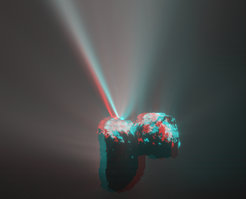Rosetta sees first jets in 3d
For the first time since its arrival at comet 67P/Churyumov-Gerasimenko, OSIRIS, the scientific imaging system on board ESA’s Rosetta spacecraft, has observed a dust jet emitted from the comet in a fashion that allows to create a three dimensional anaglyph of the feature. The jet occurred a day before perihelion in phase of high cometary activity.

Close to perihelion and in the weeks after, Rosetta’s comet has displayed a true firework of activity with several pronounced jets emitted from its surface. Creating a 3d anaglyph off these jets, however, is notoriously difficult. Often the jets are too faint or their duration is too short to render two high-quality images several minutes apart that could be put together to form a three dimensional representation. However, on 12 August, 2015 the OSIRIS team was lucky: two images taken almost two and a half minutes apart were suitable to create a spectacular anaglyph. It shows a bright, collimated jet embedded in a broader emission structure. The three dimensional perspective reveals the conical shape of the jet and that the collimated feature is emitted towards the observer.
Jets originate from a large diversity of morphological features on the comet’s surface, for example pits, cliffs or icy boulder fields. Some of the jets display a clearly visible fine structure. The physical processes responsible for these structures are still subject to debate. Anaglyphs can help in gaining an understanding of their three dimensional form and evolution.
Rosetta is an ESA mission with contributions from its member states and NASA. Rosetta's Philae lander is provided by a consortium led by DLR, MPS, CNES and ASI. Rosetta is the first mission in history to rendezvous with a comet, escort it as it orbits the Sun, and deploy a lander to its surface.
The scientific imaging system OSIRIS was built by a consortium led by the Max Planck Institute for Solar System Research (Germany) in collaboration with CISAS, University of Padova (Italy), the Laboratoire d'Astrophysique de Marseille (France), the Instituto de Astrofísica de Andalucia, CSIC (Spain), the Scientific Support Office of the European Space Agency (The Netherlands), the Instituto Nacional de Técnica Aeroespacial (Spain), the Universidad Politéchnica de Madrid (Spain), the Department of Physics and Astronomy of Uppsala University (Sweden), and the Institute of Computer and Network Engineering of the TU Braunschweig (Germany). OSIRIS was financially supported by the national funding agencies of Germany (DLR), France (CNES), Italy (ASI), Spain (MEC), and Sweden (SNSB) and the ESA Technical Directorate.
